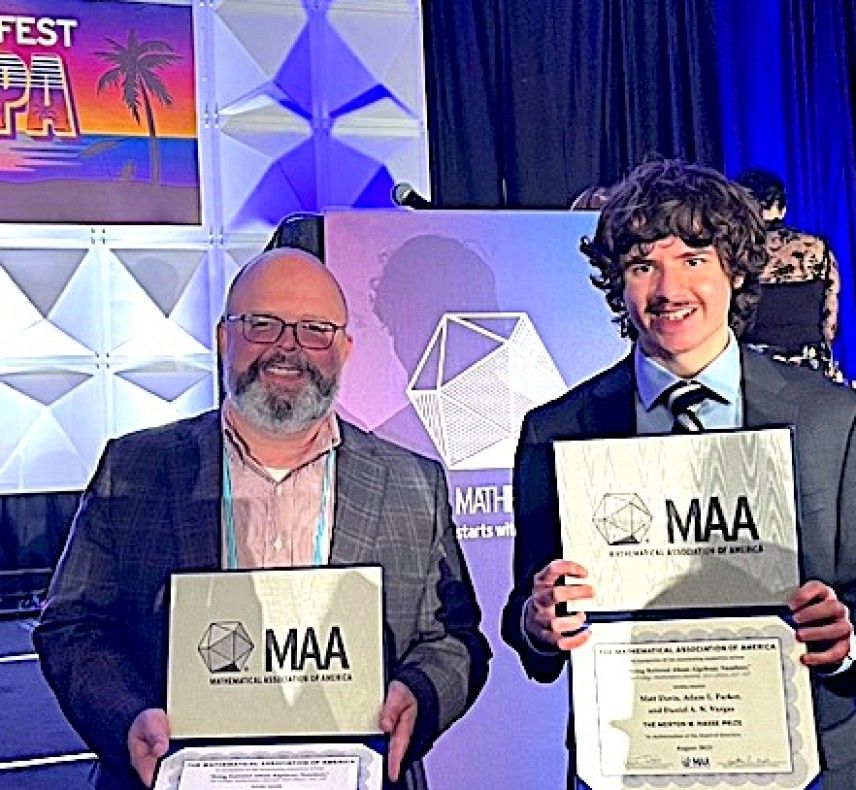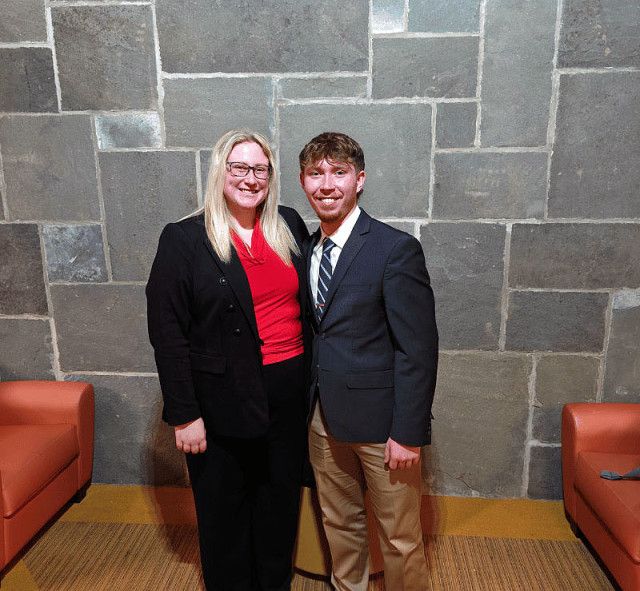Adam Parker loves being rational, especially when it comes to algebraic numbers. Being the rational type, the longtime math professor wasn’t expecting to receive a writing award for a recent mathematics publication.
Parker, the 2018 Alumni Association Award for Distinguished Teaching recipient and former chair of Wittenberg’s department of mathematics, recently collaborated with two other mathematicians on a paper titled ‘Being Rational About Algebraic Numbers,’ which was published in The College Mathematics Journal. This past August, the trio was recognized by the Mathematical Association of America (MAA) with the Merten M. Hasse Prize during the organization’s national convention in Tampa, Florida. The MAA presents the award every two years.
The event marked the second time Parker received a writing award from the MAA, the world’s largest community of mathematicians, students, and enthusiasts. He won the George Pólya Writing Award in 2013 for another paper in The College Math Journal followed by the MAA Ohio Section Distinguished Teaching Award in 2018.
“I am very honored to have won the 2023 Merten Hasse Award,” Parker said. “This was more of a writing award than a math award, but it was given for the math and for the way it was presented, which shows the importance of being able to communicate your thoughts to a wide audience. It’s the reason we have writing intensive courses, editing, and revising in writing and a Writing Center at Wittenberg – all part of the liberal arts curriculum. You would think there would be no connection between writing and math – however that’s not true and winning an award like this makes the connection valid.”
The Background Story
According to Parker, “the Merten M. Hasse Prize is “for a noteworthy expository paper appearing in an association publication, at least one of whose authors is a younger mathematician, generally under the age of 40. In this case, the collaboration was with a mathematician MUCH younger than 40!”
About five, maybe six years ago, Parker said he received an email from a former student, Wiley Stemple, who was a 7th grade math teacher in Texas at the time.
“Wiley is a great kid, transferred after a bit, and ended up becoming a 7th grade math teacher in Houston at a private school. He reached out to me about a student in his class, who was just writing down a bunch of symbols in math. He had no idea what the student was doing so he asked if I would reach out to him,” Parker explained.
“I did, and he sent me a lot of the stuff he had written down, most of it was stuff I’d seen, but then there was something I didn’t recognize,” Parker added. “By playing with spreadsheets etc., he came up with this pattern. I asked colleagues about it to see if anyone was aware of the result or if we could prove the pattern continued.”
And that’s where Matt Davis comes in. An associate professor of mathematics at Muskingum University, he and Parker met at a lecture for the Ohio MAA. Davis received his Ph.D. from the University of Wisconsin in 2010. His research interests include combinatorics and voting theory, and he is active in the Ohio MAA, having served as the chair of the Program Committee in 2020-2021.
Parker, who started his career at Wittenberg in 2005, earned degrees in mathematics and psychology at the University of Michigan and received his Ph.D. in algebraic geometry from the University of Texas at Austin. His main research interests are algebraic geometry and the history of mathematics.
Davis saw Parker present a talk on the pattern at a conference at Kenyon College.
“We worked together on the proof and were able to do it. It took us a good year to get the result and another half year to write it up, which is pretty common in math research. We wrote it up as a problem, did the proof, and submitted our work,” Parker said. “We just kind of forgot about it after that, and it fell off the radar. Then, recently, we were published, and not long after received the award.”
The 7th-grade student was Daniel Vargas, who, has since graduated from Emery Weiner School in Houston, Texas, and is now a sophomore at Harvey Mudd College majoring in mathematics. He recently became an Eagle Scout with his service project involving creating videos to teach physics to middle school students. In addition to mathematics, he also likes to write music.
Parker and Davis met a few times to work on the problem and communicated with Vargas through emails. Then Parker and Vargas met for the first time in person when they accepted the award during the MAA national convention this summer.
The Synopsis of the Project, Explained by Parker
Parker explained that methods for finding close approximations of irrational numbers have long been of interest to mathematicians.
“If you type ‘the square root of two’ into your calculator, you will get something like 1.414213562373095. But that isn’t exactly true. Since Hippasus in the 5th century BC, we have known that \sqrt{2} cannot be written as a decimal that ends (or repeats). So 1.414213562373095 (which ends at 5) must only be an approximation of \sqrt{2}. A very good approximation, but still just an approximation.
In reality, an approximation is almost always good enough. Pi is a number like \sqrt{2}, which cannot be written as a decimal that ends (or repeats). We will never know all of its digits. But with computers we’ve amazingly calculated 62.8 trillion digits. That isn’t close to ‘all,’ but at the same time we would only need 39 decimal places to measure the circumference of the known universe to the width of a hydrogen atom and therefore, 62.8 trillion digits is just a bit overkill.
Our collaborator, Daniel, hypothesized a way to systematically create numbers that approximate a type of numbers called algebraic. Now we have a new way to approximate the algebraic number within 39 digits or to within 62.8 trillion digits. Not only was that useful, but after Matt and I verified Daniel’s hypothesis, it was clear it was an extension of a method used for centuries to approximate the square root of numbers. Since there are more algebraic numbers, and they contain all the square roots, this was a nice leap forward.”
For more information or to read the article in the MAA Journal, click here.






